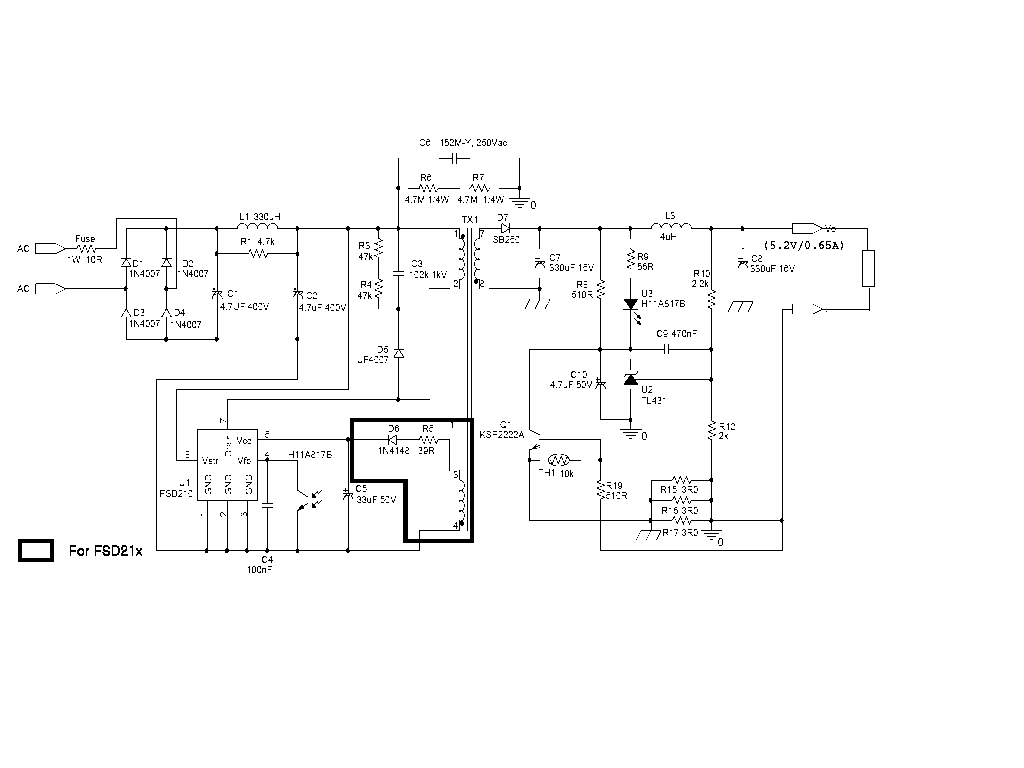1、恒流行:电流恒定不变,电压下降
2、回卷型:初始电流恒定不变,电压下降到一定数值电流开始减小.
3、限功率型:限定输出的总功率
4、打隔型:过流后,电流电压下降到0,然后又开始上升,周而复始.
5:复合型:将多种保护符合起来.
我所知道的就这些,希望大家讨论各种方式以及实现的方法和使用的场合.
过流保护的几种方式
全部回复(98)
正序查看
倒序查看
现在还没有回复呢,说说你的想法
@shandongtao
恒压式比较好!在有负载时
我看到这样一个资料,其中关于电流限制这方面的电路没有弄清楚.
Key Design Notes
• The constant voltage (CV) mode control is implemented with resistors, R8, R9, R10 and R11, shunt regulator, U2, feedback
capacitor, C9 and opto-coupler, U3.
• The constant current (CC) mode control is designed with resistors, R8, R9, R15, R16, R17 and R19, NPN transistor, Q1 and
NTC, TH1. When the voltage across current sensing resistors, R15,R16 and R17 is 0.7V, the NPN transistor turns on and the
current through the opto coupler LED increases. This reduces the feedback voltage and duty ratio. Therefore, the output
voltage decreases and the output current is regulated.
• The NTC(negative thermal coefficient) is used to compensate the temperature characteristics of the transistor Q1.
它是如何来控制电流的呢
 500) {this.resized=true; this.width=500; this.alt='这是一张缩略图,点击可放大。\n按住CTRL,滚动鼠标滚轮可自由缩放';this.style.cursor='hand'}" onclick="if(!this.resized) {return true;} else {window.open('http://u.dianyuan.com/bbs/u/26/1107398247.gif');}" onmousewheel="return imgzoom(this);">
500) {this.resized=true; this.width=500; this.alt='这是一张缩略图,点击可放大。\n按住CTRL,滚动鼠标滚轮可自由缩放';this.style.cursor='hand'}" onclick="if(!this.resized) {return true;} else {window.open('http://u.dianyuan.com/bbs/u/26/1107398247.gif');}" onmousewheel="return imgzoom(this);">
Key Design Notes
• The constant voltage (CV) mode control is implemented with resistors, R8, R9, R10 and R11, shunt regulator, U2, feedback
capacitor, C9 and opto-coupler, U3.
• The constant current (CC) mode control is designed with resistors, R8, R9, R15, R16, R17 and R19, NPN transistor, Q1 and
NTC, TH1. When the voltage across current sensing resistors, R15,R16 and R17 is 0.7V, the NPN transistor turns on and the
current through the opto coupler LED increases. This reduces the feedback voltage and duty ratio. Therefore, the output
voltage decreases and the output current is regulated.
• The NTC(negative thermal coefficient) is used to compensate the temperature characteristics of the transistor Q1.
它是如何来控制电流的呢
 500) {this.resized=true; this.width=500; this.alt='这是一张缩略图,点击可放大。\n按住CTRL,滚动鼠标滚轮可自由缩放';this.style.cursor='hand'}" onclick="if(!this.resized) {return true;} else {window.open('http://u.dianyuan.com/bbs/u/26/1107398247.gif');}" onmousewheel="return imgzoom(this);">
500) {this.resized=true; this.width=500; this.alt='这是一张缩略图,点击可放大。\n按住CTRL,滚动鼠标滚轮可自由缩放';this.style.cursor='hand'}" onclick="if(!this.resized) {return true;} else {window.open('http://u.dianyuan.com/bbs/u/26/1107398247.gif');}" onmousewheel="return imgzoom(this);"> 0
回复
提示
@jiurl
我看到这样一个资料,其中关于电流限制这方面的电路没有弄清楚.KeyDesignNotes•Theconstantvoltage(CV)modecontrolisimplementedwithresistors,R8,R9,R10andR11,shuntregulator,U2,feedbackcapacitor,C9andopto-coupler,U3.•Theconstantcurrent(CC)modecontrolisdesignedwithresistors,R8,R9,R15,R16,R17andR19,NPNtransistor,Q1andNTC,TH1.Whenthevoltageacrosscurrentsensingresistors,R15,R16andR17is0.7V,theNPNtransistorturnsonandthecurrentthroughtheoptocouplerLEDincreases.Thisreducesthefeedbackvoltageanddutyratio.Therefore,theoutputvoltagedecreasesandtheoutputcurrentisregulated.•TheNTC(negativethermalcoefficient)isusedtocompensatethetemperaturecharacteristicsofthetransistorQ1.它是如何来控制电流的呢[图片]500){this.resized=true;this.width=500;this.alt='这是一张缩略图,点击可放大。\n按住CTRL,滚动鼠标滚轮可自由缩放';this.style.cursor='hand'}"onclick="if(!this.resized){returntrue;}else{window.open('http://u.dianyuan.com/bbs/u/26/1107398247.gif');}"onmousewheel="returnimgzoom(this);">
我不是十分熟悉你这个芯片,我理解是这样的:
1、输出电流增加,R15\16\17\上的压降增加
2、造成Q1控制记得电压增加,Q1导通
3、光偶U3导通,造成芯片的4P拉低,进入稳流!
如有不正确,请批评!!!
1、输出电流增加,R15\16\17\上的压降增加
2、造成Q1控制记得电压增加,Q1导通
3、光偶U3导通,造成芯片的4P拉低,进入稳流!
如有不正确,请批评!!!
0
回复
提示
@jiurl
我看到这样一个资料,其中关于电流限制这方面的电路没有弄清楚.KeyDesignNotes•Theconstantvoltage(CV)modecontrolisimplementedwithresistors,R8,R9,R10andR11,shuntregulator,U2,feedbackcapacitor,C9andopto-coupler,U3.•Theconstantcurrent(CC)modecontrolisdesignedwithresistors,R8,R9,R15,R16,R17andR19,NPNtransistor,Q1andNTC,TH1.Whenthevoltageacrosscurrentsensingresistors,R15,R16andR17is0.7V,theNPNtransistorturnsonandthecurrentthroughtheoptocouplerLEDincreases.Thisreducesthefeedbackvoltageanddutyratio.Therefore,theoutputvoltagedecreasesandtheoutputcurrentisregulated.•TheNTC(negativethermalcoefficient)isusedtocompensatethetemperaturecharacteristicsofthetransistorQ1.它是如何来控制电流的呢[图片]500){this.resized=true;this.width=500;this.alt='这是一张缩略图,点击可放大。\n按住CTRL,滚动鼠标滚轮可自由缩放';this.style.cursor='hand'}"onclick="if(!this.resized){returntrue;}else{window.open('http://u.dianyuan.com/bbs/u/26/1107398247.gif');}"onmousewheel="returnimgzoom(this);">
R11在哪儿?
0
回复
提示
@jiurl
基极的电压是否通过NTC(TH1)电阻反馈得到的?Q1没有导通就是说基极的电压没有达到0.7V,R15~17流过的电流不够大,是吗,那么这个电流回路是在那里呢.呵呵,还是有些不太明白.
看看图P 500) {this.resized=true; this.width=500; this.alt='这是一张缩略图,点击可放大。\n按住CTRL,滚动鼠标滚轮可自由缩放';this.style.cursor='hand'}" onclick="if(!this.resized) {return true;} else {window.open('http://u.dianyuan.com/bbs/u/26/1107409994.gif');}" onmousewheel="return imgzoom(this);">
500) {this.resized=true; this.width=500; this.alt='这是一张缩略图,点击可放大。\n按住CTRL,滚动鼠标滚轮可自由缩放';this.style.cursor='hand'}" onclick="if(!this.resized) {return true;} else {window.open('http://u.dianyuan.com/bbs/u/26/1107409994.gif');}" onmousewheel="return imgzoom(this);">
 500) {this.resized=true; this.width=500; this.alt='这是一张缩略图,点击可放大。\n按住CTRL,滚动鼠标滚轮可自由缩放';this.style.cursor='hand'}" onclick="if(!this.resized) {return true;} else {window.open('http://u.dianyuan.com/bbs/u/26/1107409994.gif');}" onmousewheel="return imgzoom(this);">
500) {this.resized=true; this.width=500; this.alt='这是一张缩略图,点击可放大。\n按住CTRL,滚动鼠标滚轮可自由缩放';this.style.cursor='hand'}" onclick="if(!this.resized) {return true;} else {window.open('http://u.dianyuan.com/bbs/u/26/1107409994.gif');}" onmousewheel="return imgzoom(this);"> 0
回复
提示
@
看看图P[图片]500){this.resized=true;this.width=500;this.alt='这是一张缩略图,点击可放大。\n按住CTRL,滚动鼠标滚轮可自由缩放';this.style.cursor='hand'}"onclick="if(!this.resized){returntrue;}else{window.open('http://u.dianyuan.com/bbs/u/26/1107409994.gif');}"onmousewheel="returnimgzoom(this);">
R15~17的两端产生压降的回路我还是没有搞清楚,当通过电阻的电流很小的情况下,Q1不会导通,这个回路是负载-R15~17-TH1-R19-负载的吗???
0
回复
提示
@jiurl
我看到这样一个资料,其中关于电流限制这方面的电路没有弄清楚.KeyDesignNotes•Theconstantvoltage(CV)modecontrolisimplementedwithresistors,R8,R9,R10andR11,shuntregulator,U2,feedbackcapacitor,C9andopto-coupler,U3.•Theconstantcurrent(CC)modecontrolisdesignedwithresistors,R8,R9,R15,R16,R17andR19,NPNtransistor,Q1andNTC,TH1.Whenthevoltageacrosscurrentsensingresistors,R15,R16andR17is0.7V,theNPNtransistorturnsonandthecurrentthroughtheoptocouplerLEDincreases.Thisreducesthefeedbackvoltageanddutyratio.Therefore,theoutputvoltagedecreasesandtheoutputcurrentisregulated.•TheNTC(negativethermalcoefficient)isusedtocompensatethetemperaturecharacteristicsofthetransistorQ1.它是如何来控制电流的呢[图片]500){this.resized=true;this.width=500;this.alt='这是一张缩略图,点击可放大。\n按住CTRL,滚动鼠标滚轮可自由缩放';this.style.cursor='hand'}"onclick="if(!this.resized){returntrue;}else{window.open('http://u.dianyuan.com/bbs/u/26/1107398247.gif');}"onmousewheel="returnimgzoom(this);">
应该是用U2调节的吧
0
回复
提示
@jiurl
基极的电压是否通过NTC(TH1)电阻反馈得到的?Q1没有导通就是说基极的电压没有达到0.7V,R15~17流过的电流不够大,是吗,那么这个电流回路是在那里呢.呵呵,还是有些不太明白.
回路是这样的:
 500) {this.resized=true; this.width=500; this.alt='这是一张缩略图,点击可放大。\n按住CTRL,滚动鼠标滚轮可自由缩放';this.style.cursor='hand'}" onclick="if(!this.resized) {return true;} else {window.open('http://u.dianyuan.com/bbs/u/26/1107425050.jpg');}" onmousewheel="return imgzoom(this);">
500) {this.resized=true; this.width=500; this.alt='这是一张缩略图,点击可放大。\n按住CTRL,滚动鼠标滚轮可自由缩放';this.style.cursor='hand'}" onclick="if(!this.resized) {return true;} else {window.open('http://u.dianyuan.com/bbs/u/26/1107425050.jpg');}" onmousewheel="return imgzoom(this);">
 500) {this.resized=true; this.width=500; this.alt='这是一张缩略图,点击可放大。\n按住CTRL,滚动鼠标滚轮可自由缩放';this.style.cursor='hand'}" onclick="if(!this.resized) {return true;} else {window.open('http://u.dianyuan.com/bbs/u/26/1107425050.jpg');}" onmousewheel="return imgzoom(this);">
500) {this.resized=true; this.width=500; this.alt='这是一张缩略图,点击可放大。\n按住CTRL,滚动鼠标滚轮可自由缩放';this.style.cursor='hand'}" onclick="if(!this.resized) {return true;} else {window.open('http://u.dianyuan.com/bbs/u/26/1107425050.jpg');}" onmousewheel="return imgzoom(this);"> 0
回复
提示
@
看看图P[图片]500){this.resized=true;this.width=500;this.alt='这是一张缩略图,点击可放大。\n按住CTRL,滚动鼠标滚轮可自由缩放';this.style.cursor='hand'}"onclick="if(!this.resized){returntrue;}else{window.open('http://u.dianyuan.com/bbs/u/26/1107409994.gif');}"onmousewheel="returnimgzoom(this);">
设Q1基极电压为Vb,be间电压为0.7伏.则有,基极电流为:Vb/R19-0.7/TH1,Vb=0.7-(Io-Vb/R19)*1欧姆--第一式,同时三极管射集电流为:B(放大倍数)*(Vb/R19-0.7/TH1),则有Io=B(放大倍数)*(Vb/R19-0.7/TH1)+0.7/TH1--第二式,把第二式代入第一式,显然输出电流只和Q1的电流放大倍数有关,所以这个电源要做到限流的一致性,B(放大倍数)是要进行筛选的,如果不筛选,限流一致性会很差.
0
回复
提示

